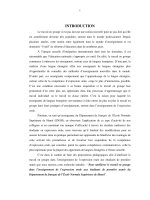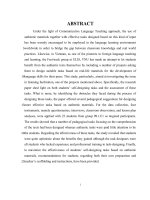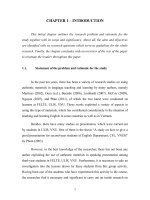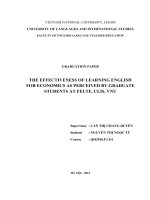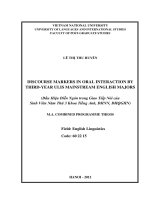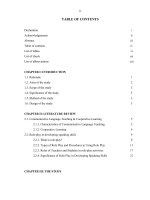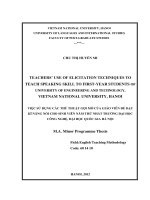VIỆC KHAI THÁC NGỮ LIỆU THỰC tế TRONG bài THUYẾT TRÌNH kĩ NĂNG nói của SINH VIÊN năm THỨ BA, KHOA sư PHẠM TIẾNG ANH
Bạn đang xem bản rút gọn của tài liệu. Xem và tải ngay bản đầy đủ của tài liệu tại đây (337.41 KB, 50 trang )
CHAPTER 1 – INTRODUCTION
This initial chapter outlines the research problem and rationale for the
study together with its scope and significance. Above all, the aims and objectives
are identified with six research questions which serve as guidelines for the whole
research. Finally, the chapter concludes with an overview of the rest of the paper
to orientate the readers throughout this paper.
1.1. Statement of the problem and rationale for the study
In the past ten years, there has been a variety of research studies on using
authentic materials in language teaching and learning by many authors, namely
Martinez (2002), Oura (n.d.), Berardo (2006), Lombardi (2007), McCoy (2009),
Nguyen (2007), and Phan (2011), of which the two latest were conducted on
learners at FELTE, ULIS, VNU. Those works exploited a variety of aspects in
using this type of materials, which has contributed considerately to the situation of
teaching and learning English in some countries as well as in Vietnam.
Besides, there have many studies on presentation, which were carried out
by students in ULIS, VNU. One of them is the thesis “A study on how to give a
good presentation for second-year students of English Department, CFL, VNUH”
by Pham (2003).
However, to the best knowledge of the researcher, there has not been any
author exploiting the use of authentic materials in speaking presentation among
third-year students in FELTE, ULIS, VNU. Furthermore, it is necessary to take an
investigation into the lessons drawn by these students from this group activity.
Having been one of the students who have experienced this activity in the course,
the researcher find it necessary and significant to carry out an inside research on
1
the aspect of working with authentic materials for speaking presentations. The real
situation has inspired the researcher to convey the topic “The exploitation of
authentic materials in speaking presentations by third-year students, FELTE,
ULIS, VNU” with the expectation to fill in the gap of the previous studies.
1.2. Aims of the study and research questions
This study, firstly, is going to discuss students’ perceptions of authentic
materials. Secondly, it aims to find out the reasons why the students chose to use
authentic materials in their speaking presentations. Next, the researcher desires to
exploit the difficulties that the students faced when using these materials.
Furthermore, the researcher expects to discover the students’ methods of
exploiting authentic materials in completing this activity or in other words, their
solutions to the difficulties they encounter. Finally, the researcher also aims to
exploit some lessons drawn by the students throughout their process of working
with authentic materials to carry out their presentations.
Those aims will be reached by the responses to six research questions:
1. What are authentic materials as perceived by the students?
2. Why and how did the students use authentic materials for their speaking
presentations?
3. What is the relation between the students’ use of authentic materials and
teacher’s comments?
4. What were the difficulties that the students encountered when using authentic
materials?
2
5. What did the students do to overcome the difficulties in using authentic
materials?
6. What is the difference in the use of authentic materials between main-stream
students and fast-track students?
1.3. Significance of the study
Once having been completed, this research would be of benefits for the
target population including teachers and students, policy makers as well as other
researchers who are interested in the same field.
To begin with, as the research problem has stated, the findings of this study
would contribute to students’ awareness in their use of real-life materials. This
hopefully would provide students with a theoretical base and enhance their study
skills and working skills in the future.
Besides, the findings discussed in Chapter 4 and the implications provided
in Chapter 5 of this study would be used as a helpful source for teachers and
policy makers. To be specific, students’ understanding about authentic materials,
their difficulties in using authentic materials in speaking presentations and their
solutions to those difficulties will be presented in the fourth chapter. In the fifth
chapter, pedagogical implications will be suggested by the researcher with the aim
to make the best use of students’ awareness of authentic materials in their
speaking presentations.
Last but not least, this study hopefully would be a reliable source for other
researchers who are interested in the same field. The data, findings and
3
implications will be available and free for them to access. Besides, they could
learn from some limitations of this study.
1.4. Scope of the study
First, materials in general are categorized into many types. In this study,
the focus is on authentic materials employed by students.
Second, authentic materials can be used for various purposes and fields.
However, the paper only investigates the use of authentic materials in speaking
presentations by English learners at FELTE, ULIS, VNU.
Third, the scope is narrowed to a population of 87 third-year students
including 80 students in main-stream group and 7 students in fast-track group, and
a teacher who was in charge of speaking skills in the fast-track group in semester
1, academic year 2011-2012.
1.5. Methodology
1.5.1. Data collection methods
Survey questionnaires and interviews were combined to collect the data
from the target population. To be specific, the same set of questionnaire was
employed to survey third-year main-stream students and fast-track students. After
the data from survey questionnaire was synthesized, two semi interviews with a
main-stream student and a fast-track student were carried out for the sake of
thoroughly investigated data. Simultaneously, a set of questions for interview was
sent to the target teacher to exploit his opinions on his students’ use of authentic
materials in their speaking presentations.
4
It should be noted that all of the survey questionnaires and interviews’
questions were designed by the researcher, based on the researcher’s purposes of
employing the data, and were delivered to the participants in the second semester
of academic year 2011-2012. Besides, the language used in survey questionnaires
was simple English so that the participants had not difficulty in answering. Next,
Vietnamese was encouraged in the interviews with the students for the sake of
clear and understandable expressions and opinions, and friendly face-to-face
atmosphere. In fact, English was recognized sometimes in the interviews when the
students wanted to use the accurate terminologies. However, the interview with
the teacher was carried out online and in English because the teacher was not
available in Vietnam at the time of the interview. There was only one interview,
with the fast-track student, was recorded as she agreed to do so.
1.5.2. Data analysis methods
Firstly, the data from the survey questionnaire was decoded and
summarized into tables and charts. From this result, the researcher made use of
relevant interview questions to illustrate those quantitative data.
Secondly, the interviews with teacher and students would be transcribed
and synthesized. By researching the data, the answers by the students and the
teacher were presented in tables and figures so that the would find it convenient to
follow. Data from the interview with the teacher would be used for answering
research question 3. Meanwhile, all of the answers collected from the students
would be employed to answer six research questions of this study.
5
The data collected from the questionnaires and the data from the interviews
were analyzed separately. After that, they were combined together to answer all of
the research questions.
1.6. An overview of the rest of the paper
The rest of the paper includes five chapters as follows:
Chapter 2 (Literature review) provides the background of the study,
including definition of key concepts, description of the context in which speaking
presentations are conducted in FELTE, ULIS, VNU.
Chapter 3 (Methodology) describes the participants and instruments of the
study, as well as the procedure employed to carry out the research.
Chapter 4 (Results and discussion) presents, analyzes and discusses the
findings that the researcher found out from the data collected according to seven
research questions.
Chapter 5 (Recommendations) presents the researcher’s suggestions to
resolve remaining problems in using authentic materials in speaking presentations
in FELTE, ULIS, VNU.
Chapter 6 (Conclusion) summarizes the main issues discussed in the paper,
the limitations of the research as well as some suggestions for further studies.
Following this chapter are the References and Appendices.
6
In this chapter, the researcher has elaborated on the following points:
(1) Statement and rationale for the study
(2) Aims and objectives of the study
(3) Scope of the study
(4) Methods of the study
(5) An overview of the rest of the paper
Summary
The chapter has provided the rationale for the study by stressing the role
of authentic materials in language learning and teaching as well as disclosing the
research gap. The framework of the paper has also been elaborated on with the
six research questions and clearly defined scope. These elaborations have not
only justified the major contents and structure of the study but will also work as
the guidelines for the rest of the paper.
7
CHAPTER 2 - LITERATURE REVIEW
This second chapter, as the name says it, sheds light on the literature of the
study, specifically the background and a number of studies related to the research
topic. In this chapter, a detailed presentation of the research background will be
provided with the four key concepts “speaking presentations”, “authenticity”,
“materials” and “authentic materials” critically identified, together with a brief
discussion of the context of speaking presentations conducted in FELTE, ULIS,
VNU. Literature gap in previous studies will be offered simultaneously in the
discussion of the key concepts.
2.1. Speaking presentation
2.1.1. The concept of speaking and speaking presentation
According to Oxford Advanced Learner’s Dictionary, the verb “speak”
means “to talk to somebody about something” or “to have a conversation with
somebody”, and “presentation” means “the act of showing something or of giving
something to somebody”.
Meanwhile, some authors have defined speaking as “an interactive process
of constructing meaning that involves producing and receiving and processing
information” (Brown, 1994; Burns & Joyce, 1997, cited in Florez, 1999).
Brown (1994, cited in Florez, 1999) has stated that speaking is one of the
two most used skills in classroom, together with listening. Sharing a similar
concern with Brown, perceived “public speaking and presentation skills are in
much demaand in today’s world” (Coombe, England & Schmidt, 2011). Coombe,
England and Schmidt (2011) also cited an advice by Osborn and Osborn (2004)
8
that “good orals and written skills can be your most possession” regarding their
role in job searching.
2.1.2. Speaking presentation in the CLT context
Communicative language teaching (CLT) emphasize on group work and,
therefore, materials for classroom in the CLT context promote teachers and
learners to “make use of a wide variety of small-group activities” (Richards,
2006). The speaking presentations exploited in this research study belong to a
group activity in five speaking classes.
Moreover, CLT is supposed to foster authenticity in general, and the use of
authentic materials in particular, as it provides learners “a preparation for survival
in the real world” (Richards, 2006).
2.2. Authenticity
2.2.1. The concept of authenticity
The concept of authenticity has been discussed for years and “creates
confusion because of a basic ambiguity” (Widdowson 1983, p.30 as cited in
Mishan 2004). Multiple interpretations of the term have emerged in many studies
by scholars and theorists, which results in the immensity of definitions.
According to Grellet (1981, p.8 as cited in Mishan 2004, p.13),
“authenticity means that nothing of the original text is changed and also that its
presentation and layout are retained”. In his book, Mishan (2004, p.13)) also cites
some quotations by some well-known experts in the field of authenticity to support
the idea about the originality and the uniqueness of authentic texts.
9
Another approach to the understanding of authenticity is suggested by
Rogers and Medley (1988, as cited in Shimoossi & Ketabi 2007, p.150) is that
“authenticity is the naturalness of form, and appropriateness of cultural and
situational context”. However, Chavez (1998, as cited in Shomoossi & Ketabi
2007, p.150) clarifies that authenticity cannot be defined as “anything really
existing in the outside world” since “any text taken out of its original context and
away from its intended audience automatically becomes inauthentic”. In other
words, authenticity is created in the process of bringing an item from the real life
to the users’ situations.
Those definitions are even not detailed enough to persuade the researchers
who refer authenticity to “the acts of authentication by students and their teacher”
(Van Lier 1996, p128, as cited in Mishan 2004, p.15). Two years later, this
opinion by Van Lier was also mentioned in the theoretical base of Bacha’s work as
authenticity is a “process of personal engagement” and dependent on “a learner’s
self determination and commitment to understanding” (Van Lier, 1996 cited in
Bacha, 2006). Back to 1995, Lee (as cited in Shomoossi & Ketabi 2007, p.150)
also agrees that authenticity must be built up “through the interaction of the users,
situations and the texts. By synthesizing the opinions about learners’ engagement
and interaction with materials, Mishan (2004, p.15) states that authenticity is
“associated less with the text” than with the learners’ “interactions” with that text.
2.2.2. The importance of authenticity in language learning
As the topic authenticity has become “problematic within a framework of
English as an international language” (Kramsch & Sullivan, 1996), many
researchers raise their concern about the benefits that authenticity brings to
language users.
10
According to Garcia-Carbonell et al. (2001, as cited in Phan, 2011, p.26),
researchers and practitioners of EFL “have faced the issue of communicative
competence as a goal in language acquisition”. This communicative movement
has raised the awareness of developing students’ skills that can be used in the
outside world (Guariento and Morley, 2001, as cited in Vahid baghban & Pandian,
2011, p.1). Moreover, authentic learning opens up to “real-life decision making”
and “lifelong skills” and, thus, prepare students with the awareness of “the
complexities of ill-defined real-world problems” (Lombardi, 2007, p.10).
Several related studies suggest that authenticity provides language learners
“both linguistics and cultural information that they may not be available in
pedagogical texts used in traditional classroom” (Kim 2000, p.190, as cited in
Phan, 2011, p.25). This researcher also states that authenticity considerably
contributes to the process of “overcoming certain cultural barriers to language
learning” (Kim, 2000, as cited in Al-Musallam, 2006, p.4). Besides, Rogers and
Medley (1988, as cited in Mousavi & Iravani, 2012, p.2) agree that learners have
to use real-world language if they want to develop their “functional proficiency”
and real-world communication.
The issue of authenticity filling the gap in language between classroom and
real life has been recently raised by Adam et al. (2010) as it helps learners
“understand all written or oral materials containing real, not processed language,
produced by a real speaker or for a real audience and in a real situation”.
According to Lebow and Wager (1994, p.3, as cited in Phan 2011, p.26), a
significant job of education is to transfer the production from the stage “knowing
something” to the latter stage “using it when relevant”. Lebow and Wager (1994,
p.3, as cited in Phan 2011, p.26), suggests a reason for the existence of the gap
11
between classroom and real world that is the lack of “the contextual features of
real-life problem-solving situations”.
Furthermore, authenticity plays a role in making language lessons more
appealing to students as they have a chance to approach what is really happening
in real life. Having studied in this field, Akar and Yildirim (2000, as cited in Oguz
& Bahar, 2008, p.331) prove that authenticity is an effective way to increase
students’ motivation and thus increase the productivity of language teaching.
Besides, teaching and learning atmosphere can be enhanced by the appearance of
authenticity since the teachers are equipped with relevant “linguistic and structural
basis” (Taylor et al., 2004, as cited in Oguz & Bahar, 2008, p.331).
2.2.3. The classification of authenticity
There are also several ways to classify authenticity since there exist several
orientations to the term authenticity.
Breen, M. (1985 cited in Al-Musallam, 2006) proposes four types of
authenticity which are in continual interrelationship with one another during any
language lesson, including text authenticity, learner authenticity, task authenticity
and situation authenticity
12
Table 1. Classification of authenticity according to Breen (1985).
Authenticity of the text or
text authenticity
The authentic qualities of a given text and a means
to help the learners develop an authentic
interpretation
Authenticity of the learners
or learner authenticity
The learners must discover the conventions of
communication in the target language which
enables them to acquire the meaning interpretation
shared among fluent language users.
Authenticity of tasks or task
authenticity
“The chosen tasks should involve the learners not
only in authentic communication with texts and
other in the classroom, but also in learning and the
purpose of learning.”
Authenticity of the actual
social situation
The provision of the conditions in which the
participants can publicly share the problems,
achievements and overall process of learning a
language together as a social activity.
Taylor (1994, as cited in Tatsuki, 2006) shares similar viewpoint. He lists
three facets of authenticity summarized in Table 4 below:
Table 2. Facets of authenticity according to Taylor (1996) and Breen (1985)
Authenticity of language Authenticity of text used as input data for learners
Authenticity of learners’ own interpretation of such
texts
Authenticity of task Authenticity of the tasks conductive to language
learning
Authenticity of situation Authenticity of the actual social situation of the
language classroom
13
Another way to classify authenticity is suggested by Philips and Clifton
(2005, p.5), which is illustrated in Figure 1:
Figure 1. Classification of authenticity according to Phillips and Clifton (2005)
2.3. Materials
2.3.1. Definition of materials
Richards and Schmidt (2002, p.333) propose a definition for the term
materials as “anything which can be used by teachers or learners to facilitate the
learning of a language”. This idea is backed up by Tomlinson (2011). Besides, he
lists many sources of materials for language learning and teaching such as “videos,
DVDs, emails, youtube, dictionaries, grammar books, readers, workbooks,
newspaper, live talks by native speakers, instructions given by a teacher, tasks
written on cards or discussions between learners” (Tomlinson, 2011, p.2). While
studying about materials development, he defines materials as “anything which is
used to increase the learners’ knowledge and/or experience of the language.” In
this study, the researcher focuses on authentic materials.
2.3.2. Materials in communicative language teaching
According to Richards (2006), communicative language teaching (CLT)
offers learners communicative competence which older methods such as
audiolingualism and situational language teaching fail to do (p.9). He points out an
approach to language teaching in the 1970s and 1980s that requires teachers to
14
“rethink their teaching, syllabuses and classroom materials” (Richards, 2006, p.9).
In other words, materials play a significant role in building up a methodological
base for communicative language teaching.
Richards and Rodgers (1986, as cited in Nguyen, 2006, p.9) divide CLT
materials into three types: text-based, task-based and realia. This research only
focuses on realia materials as it discusses the topic authenticity. While studying
about CLT materials, Nunan (1989, as cited in McKendry, 2006, p.5) argues that
materials should be found in “realia rather than textbooks” and their primary role
is “to promote comprehension and communication”. This research is going to
discuss the characteristics that make authentic materials different from other types
of materials.
2.4. Authentic materials
2.4.1. Definition of authentic materials
According to Bacon and Finnermann (1990), authentic materials are
“produced by and for native speakers of the target language” (Bacon and
Finnermann cited in The HKU Scholars Hub, n.d. pg 6).
In his journal “The effect of authentic materials on the motivation of EFL
learners in English language teaching”, Peacock (1997, cited in Berardo, 2006)
based on authentic materials’ purposes to define them as “materials that have been
produced to fulfill some social purpose in the language community.” Meanwhile,
it is agreed by Wallace (1992, cited in Berardo, 2006) that authentic materials are
“real-life texts, not written for pedagogic purposes.”
Authentic materials is regarded as those in “spoken or written” form, which
are produced for communicative purpose and not for specific pedagogic purpose
15
(Nunan, 1999, cited in Oura, n.d. pg 67). Nunan (1999) also stated that using
authentic materials could help to bring the “real world” to language classroom.
Although the definition of the term “authentic materials” has been in a
continuous debate, the researchers who are aforementioned have had the common
perception that authentic materials are those produced from and for real
communicative situations, and not for the purpose of teaching and learning
English.
2.4.2. The importance of authentic materials in a speaking presentation
2.4.2.1. Advantages of authentic materials
Firstly, the advantages of using authentic materials for children at the
kindergarten level has been worked out by Duquette, Dunnett and Papalia (1987,
cited in The HKU Scholars Hub, n.d.). After that, Allen et. al (1988, cited in The
HKU Scholars Hub, n.d.) has proved the significance of authentic texts for high
school students. From these studies, it is necessary to appreciate the important role
of authentic materials for learners at many levels.
Secondly, authentic materials are perceived by Brinton (1991, cited in
Oura, n.d.) as an enhancement in exchanging classroom language and real-world
language. Two other researchers in the field of authenticity, Clarke and Silberstein
(1977), have provided favorable arguments on this type of materials: authentic
materials “provide cultural information about the target language” and “exposure
to real language”, “relate more closely to learners’ needs”, and “support a more
creative approach to teaching” (cited in Richards, 2006).
16
Later, Nunan (1997) has emphasized the importance of learning with
authentic materials by suggesting the learners “listen and read authentic material
of as many different kinds as possible” (cited in Oura, n.d.).
Besides, Berardo (2006) has shared his personal experience that authentic
materials are more attracting to his students in comparison with the textbooks. The
materials were perceived by his students as “interesting”, “up to date” and
“stimulating”.
2.4.2.2. Problems in using authentic materials
It is undeniable that authentic materials play a significant role in language
teaching and learning nowadays. However, people has been arguing the
disadvantages of using those materials.
Firstly, Guariento and Morley (2001, cited in The HKU Scholars Hub, n.d.)
has claimed that authentic texts may not suit the learners at low levels since those
learners may find them “lexically and syntactically difficult”. Therefore, the use of
these materials sometimes causes learners’ misunderstanding and annoyance.
Another researcher who also emphasized the lexical sophistication of
authentic materials is McCoy (2009). In his study “Using authentic materials:
Keeping it real”, authentic materials were regarded as being more difficult than
the artificial materials, “unsimplified” and with “complex syntactic patterns and
vocabulary.”
Some well-known researchers such as Williams (1983), Swan (1985),
Kienbaum, Russell and Welty (1986), and Peacock (1997) has raised the need of
modifying and simplifying authentic materials so that they match the levels of
17
learners as they were aware that many of their students had found authentic
materials less attractive than the traditional or “artificial” classroom materials (The
HKU Scholars Hub, n.d.).
Widdowson (1987) and several authors were even more critical when
stating that “authentic materials often contain difficult and irrelevant language”
and that “using authentic materials is a burden for teachers” (cited in Richards,
2006).
Martinez (2002) has mentioned several disadvantages of authentic
materials: “culturally biased”, “unnecessarily difficult to understand outside the
language community”; therefore, “special preparation” is required for better
understanding.
Summary
The chapter has provided the theoretical base for the whole study through
careful elaboration on the key concepts “speaking presentations”, “authenticity”,
“materials” and “authentic materials”. The review of a number of related studies
in this chapter has revealed a literature gap which the researcher is pursuing to
bridge through this study.
18
CHAPTER 3 – RESEARCH METHODOLOGY
In the previous chapter, a brief overview of the literature on the research
topic was given, which built up a theoretical basis for the whole research study. In
this chapter, the methods applied to answer the six research questions would be
described in details. The participants, the instruments and the procedure of data
collection and data analysis would be specified.
3.1. Participants
3.1.1. Population
Speaking presentation is one of speaking activities assigned for students in
English Department who major in teaching. The students have been producing
both group presentations and individual presentations since the first semester of
the first academic year in their university. After six semesters experienced in the
activity, they are qualified enough to be invited to be participants in this study.
Besides, they are experienced in finding and selecting materials from a wide range
of sources with various genres and writing styles. Furthermore, they are aware of
the need for significant and relevant information which help them understand the
authors’ opinions and purposes implied in the materials as well. Moreover, they
are also qualified in using adequate language to express themselves. Therefore, 80
mainstream students and 7 fast-track students in FELTE, ULIS, VNU are capable
of exploiting authentic materials for their speaking presentations and providing the
research with some implications needed for completing this research.
On the other hand, the speaking skill teacher, who has been in charge of
speaking lessons of this group, experienced in teaching and studying the skill. He
also played an important role in instructing students to carry out this activity as
well as analyzing students’ works and consulting them. From the perspective of
19
the researcher, this teacher is qualified enough to become a participant of this
study.
3.1.2. Sampling method
For the sake of reliability, the samples were selected purposively by the
researcher. Speaking presentation studied by the researcher is a group activity.
Questionnaires were provided to obtained some quantitative data from the
students. After that, semi-structured interviews were conducted to investigate the
hidden perceptions behind the superficial information provided in the
questionnaire stage by the students. Both of these data collection instruments were
designed by the researcher and data collection stages took place after the groups
had carried out their speaking presentations in class. Besides, a teacher, the one
who was in charge of supervising the students in fast-track group, was interviewed
with a separate set of questions.
3.2. Data collection instruments
In order to answer five research questions, both survey questionnaire and
semi-structured interview were employed by the researcher.
3.2.1. Questionnaire
Questionnaire was selected as the main source of data for this research.
Questionnaire was defined by Brown (2011, cited in Dornyei, 2002) as “any
written instruments that present respondents with a series of questions or statement
to which they react either by writing out their answers or selecting from among
20
existing answers.” Besides, questionnaire was regarded as “being economical and
practical than individual interviews” by Mackey and Gass (2005, pg 94). Two
Vietnamese researchers Hoang and Nguyen (2006, pg 18) also had an argument in
favor of questionnaire as this is an efficient data collection instrument in terms of
time, effort and financial resources.
Multiple-choice questions are employed in order to save participants’ time
and effort. Besides, there are some open-ended questions designed with the aim to
exploiting clearer answers and examples from the participants.
3.2.2. Interview
Together with questionnaire, interview was also selected as an important
instrument to obtain the data from the participants.
Interview, among data collection instruments, was praised for allowing the
researchers to discover the reasons hidden behind the participants’ decisions and
“behaviors” by Seidman (1998, cited in McClure, 2002). Besides, according to
Mackey and Gass (2005), interview helped researchers to “investigate phenomena
that are not directly observable” (cited in Phan, 2011). Interview is recommended
in a qualitative research because it can be used as a “follow-up to certain
respondents to questionnaires” (McNamara, 1999, cited in Valenzuela &
Shrivastava, 2002). Those researchers shared the same opinion that interview had
the advantage above the other instruments for collecting data. Specifically, it is
necessary for researchers to use interview to exploit the participants’ concerns in a
face-to-face way, especially for the researcher of this study, who aim to discover
the difficulties perceived by the students in a narrow scope.
In this study, the interviews were semi-structured. The researcher decided
to use this type of interviews due to its strengths in making use of interactions and
21
exploiting evidences from the interviewers (Dowsett, 1986, as cited in Nguyen,
2007). Besides, by using semi-structured interview, the researcher had an
advantage to “give explanation and ask for clarification if the answer is not clear,
to prompt the respondent to elucidate further if necessary, and to establish his own
style of conversation” (Corbetta, 2003, as cited in Kajornboon, 2004). The
students were interviewed after they had delivered their speaking presentations in
class. After the data in survey questionnaires had been analyzed, one student in
the fast-track group and one student in the main-stream group were invited to the
interviews with the researcher. Both of the interviews with the students were based
on the same list of questions prepared by the researcher beforehand. In the
procedure of each interview, the researcher made the best use of her own
explanation to the interviewee whenever he or she doubted about the questions’
meanings. A teacher, who was in charge of speaking skills in the fast-track group,
was also invited to an interview readily prepared with a different question list from
the students. Besides, any different opinions from expected information received
from the participants were quickly jotted down to ensure the reliability and the
objectivity of this study.
The open-ended questions were used in the interviews for the sake of
thoroughly exploited data. The interviews with both students were carried out in
an informal way due to the fact that both sides, the interviewer and the
interviewees, are students and they are only one-year gap in age. During the
interviews, the researcher managed to create a friendly and comfortable
atmosphere for the participants so that the data would be collected in a natural and
reliable way. On the other hand, the interview with their teacher was taken place
online as the teacher was not in Vietnam at that time. Most of the time, the
researcher and the students used their mother tongue Vietnamese for the purpose
of avoiding misunderstandings and saving time. Besides, English was also
encouraged when the participants used some typical terms related to the subject of
22
this study. The interview with the student from fast-track group was recorded, then
transcribed and translated into English, and available for hand-in. However, the
interviews with the student from main-stream group and the teacher were not
recorded as this student was not willing to be recorded and this teacher was not
available in Vietnam.
3.3. Data collection procedure
After all of the students completed their speaking presentations in class,
survey questionnaires were delivered to all of the members. They were supposed
to finish the questionnaires independently for the sake of personal privacy and
reliability.
Next, the interviews with students and the teacher will be carried out after
all the questionnaires were collected by the researcher. An interview was be
recorded with the permission of the participant.
3.4. Data analysis and procedure
Firstly, the data from the questionnaire stage was decoding and
summarizing into tables and charts. From this result, the researcher made use of
relevant interview questions to illustrate those quantitative data.
Secondly, the interviews with teacher and students were transcribed and
synthesized. By researching the data, the experience perceived by the students and
the teacher were pointed out in paragraphs so that the readers of this research
would find it convenient to follow. Data from the interview with the teacher was
23
used for answering research question 3. Meanwhile, all of the answers collected
from the students were employed to answer six research questions of this study.
The data collected from the questionnaires and the interviews was analyzed
separately. After that, they were combined together to answer all of the research
questions.
Summary
The chapter has presented the methodology that the researchers applied to
conduct this study. Data was obtained from participants from class 091.E1,
091.E4, 091.E5 and 091.E9 at FELTE, ULIS, VNU with the use of two
instruments, survey questionnaires and interviews. The data was analyzed
carefully to ensure the validity and reliability of the research.
24
CHAPTER 4 - RESULTS AND DISCUSSION
In the previous chapter, the methodology applied to conduct this study has
been thoroughly presented with descriptions and justifications of the choice of
participants, research instruments as well as the process f data collection and
data analysis. In this chapter, all the data will be analyzed and discussed to
answer each research question respectively. Tables, charts and graphs are made
use of for better presentation and elaboration.
It should be noted that: First, each table or figure presents the data for one
question in the survey questionnaire by both main-stream students and fast-track
students. Second, in every pie chart, the circle inside illustrates the data from fast-
track group and the circle outside illustrates the data from main-stream group.
4.1. Research question 1: What are authentic materials as perceived by the
students?
Before the survey questionnaires were delivered to all the students, they
were asked whether they had heard about the term “authentic materials” before.
While all of the students from the fast-track group said “Yes”, there was only a
minority of the main-stream students said so. When being asked about their
understanding about the term “authentic materials”, third-year students including
main-stream students and fast-track student gave various answers. Specifically, all
the options for definitions suggested by the researcher in survey questionnaires
were chosen.
In a preliminary interview in a student from the fast-track group 091.E1 on
April 16, 2012, she described her knowledge about the term as “not ready-
25
